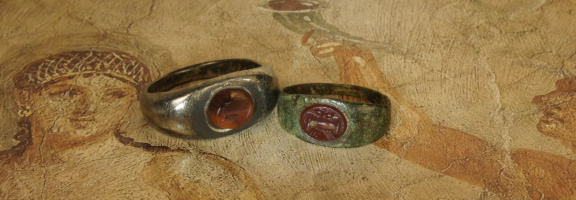While the wedding and love rings of the 17th century had a more solemn character, those of the 18th century are much more carefree and playful. Lush flower-shaped, lively and opulent forms and ornaments of the Baroque also prevailed in jewellery. In addition to the rose, the forget-me-not became extremely popular among flower motifs because of its symbolism. The German plant name "Vergissmeinnicht" has been attested since the 15th century. It probably comes from a medieval legend in which the small plant asked God not to forget it. Because the blue flowers are believed to be reminiscent of the eyes of people who have just fallen in love, the forget-me-not flower was given away as a token of love and fidelity. The plant name can be found in numerous other languages, such as forget-me-not in English, ne m'oubliez pas in French or non ti scordar di me in Italian (Fig. 09).
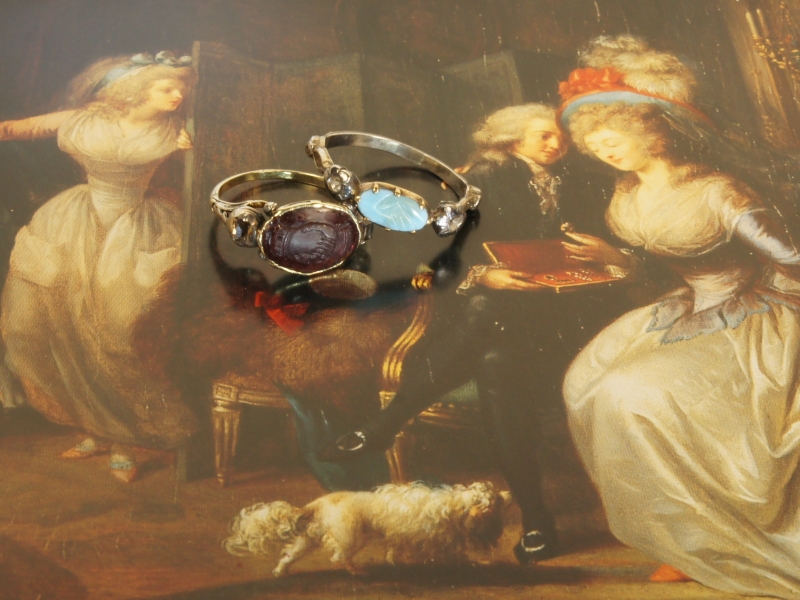
Fig. 09: Collection TN: Rococo, around 1750, gold, silver, garnet, glass, diamonds. The left Fede ring presents the mani in fede in a gemstone, a garnet cameo. The ring on the right shows the hands cut into a turquoise-blue glass stone. This is flanked on either side by flowers that probably represent forget-me-nots.
The design of the wedding rings remained very different. The simple gold or silver plated ring was popular, with a motto, Posy, the couple's initials and the wedding date inscribed on the inside of the ring hoop. In France, the marriage alliance was given the name Alliance. So that this highly prized marriage hoop did not fall off the finger, it was additionally protected with narrow diamond hoops, the slip-on rings, which were worn in pairs on each side of the wedding ring. Each ring hoop was continuously set with a row of diamonds of the same size and quality and is still known today as an alliance ring, memory ring, memoire ring or eternity ring. To this day, this type of ring is popular as a stackable ring or as a single ring, and is increasingly being chosen as an engagement ring. It was also customary for a bride to be given a ring at the wedding with the initials of her newly married name on the bezel. The mani in fede was one love symbol among many, but the most preferred in the first half of the 18th century was the emblem of twin hearts, often blazing, crowned, pierced by arrows or tied with a love knot.
The Epoch of Sensibility, a fad in the second half of the 18th century, once again made the clasped right hands one of the most popular symbols of all. Starting from contemporary literature, people adopted the sentimental attitude to life, which led to a jewellery trend with emotional content and background. The so-called sentimental jewellery such as friendship jewellery (Fig. 10) and mourning jewellery were extremely popular: in addition to the symbol of the mani in fede, there were remember-me rings, depictions of the loved one's eyes, so-called lover's eyes, jewellery made of hair, depictions of antique tombs and the old Egyptian uroboros motif of infinity, snake biting its own tail, widespread.
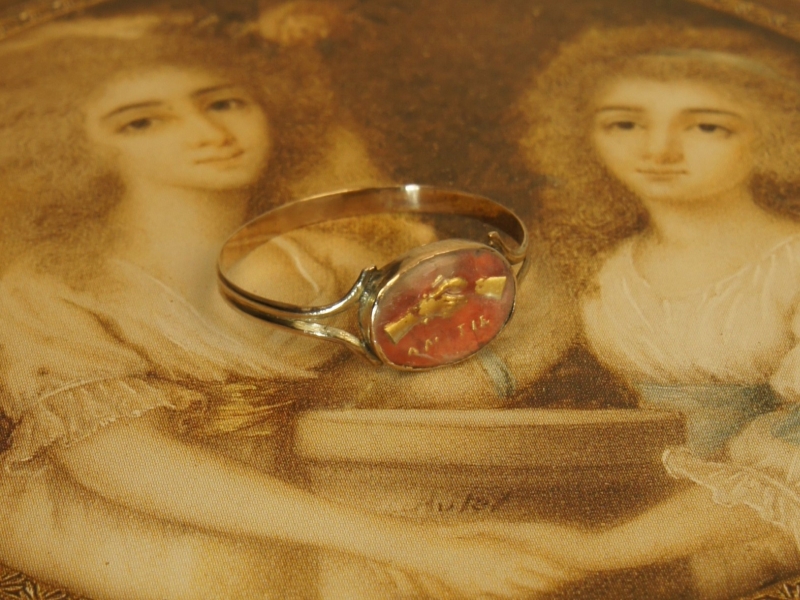
Fig. 10: Collection TN: Sensitivity, around 1810, gold, glass cabochon. Friendship ring. The ring from Goethe's time presents a glass cabochon between two elegant, curved ring shoulders. A "reverse intaglio" is cut into this from behind. The intaglio is set with gold and shows the word amitié, friendship, next to the clasped hands.
Stimulated by the emotional enthusiasm, people from the beginning of the 19th century also enjoyed the language of stones. As a little enigma, feelings and personal messages were expressed with precious stones by taking the initial letter of each stone used. The abbreviation created in this way is called an acronym. The various sentimental, emotive symbols were once again readily combined with one another.
A good example is the ring below (Fig. 11): The petals of this English Fede ring are made of different gemstones, making it an acronym ring, i.e. a piece of jewellery with a hidden message. The initial letters of these gemstones form the acronym "R-E-G-A-R-D", which in English can be translated as "respect, appreciation and admiration": Ruby / Emerald / Garnet / Amethyste / Ruby / Diamond. The bezel is decorated with an arrangement in the form of a crowned violet, recognizable by the five petals, held by two right hands, the mani in fede. The violet, which is often neglected in the German-speaking world, has a yearning, nostalgic symbolism in other languages and cultures. In French it has the nickname herbe de la pensée, meaning "plant of remembrance" and is considered a symbol of loving remembrance. The English term pansy is derived from the French pensée, in Italian the violet becomes viola del pensiero, violet of memory. The small, strongly scented violet with its five heart-shaped petals, two pointing upwards and three pointing downwards, becomes the unmistakable sentimental motif for love jewellery - after all, in the German vernacular it is not just called pansies, but also love's face.
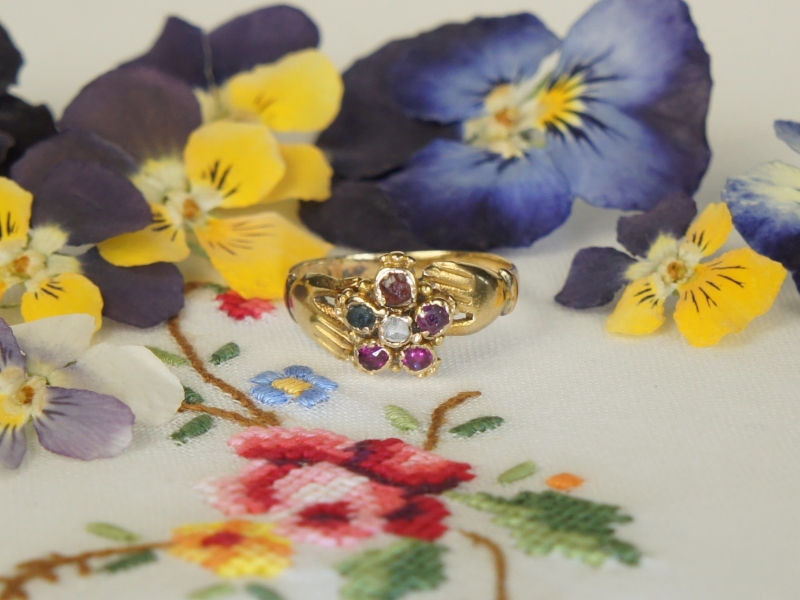
Fig. 11: TN Collection: From England, Georgian Era, circa 1820, gold and precious stones. Fede Acronym Ring. To anticipate the next chapter, this English ring from the Georgian Era sensibly embodies everything that is understood by the German Biedermeier: modesty - the stones have a diameter of approx. 2 mm, delicate shapes and a soulful motto.
Hair jewellery is characteristic of sentimental jewellery. I can't think of anything more symbolic, personal and intimate than a piece of jewellery adorned with the hair of a loved one. Even the newborn's hair was cherished and lifted in a sentimental gesture. The strands of hair of the deceased loved one were kept in mourning jewellery as a memorial: often artfully intertwined as the background plate of a mourning ring, for example the initials of the dead person placed on it, or as a melancholic image consisting of weeping willows, broken columns, urns and widows mourning at altars. The bald skulls and skeletons of earlier centuries were replaced by sentimental motifs in the 18th century. Less obviously made of hair are the antique-style miniature scenes and tableaus glued directly from hair. The hair was often ground into a fine dust, mixed into the sepia in small quantities and applied with a brush to ivory, porcelain, parchment or papier-mâché. In order to be sure that the hair of the loved one was actually used in the memorial jewellery, the ladies from middle-class and aristocratic circles made the jewellery themselves in a convivial atmosphere according to printed instructions and templates. For example, in 1822 Emilie Berrin's book, "The Hair Braid - Thorough instructions for women to make hair braids in every possible way according to the current fashion", became important teaching material. For today's viewer, it is clear whether the piece of jewellery was made by a layman or by experts. Hair braids were professionally made in Germany by hairdressers and wig makers.
Hair was also a loving reminder of the living and was exchanged between relatives, close friends and lovers in pieces of jewellery. In this sense, the motifs of love and friendship on the rings and medallions were carefree and playful, such as the forget-me-not flower, the dog for endless loyalty, the doves for motherly love and family happiness, or the mani in fede (Fig. 12).
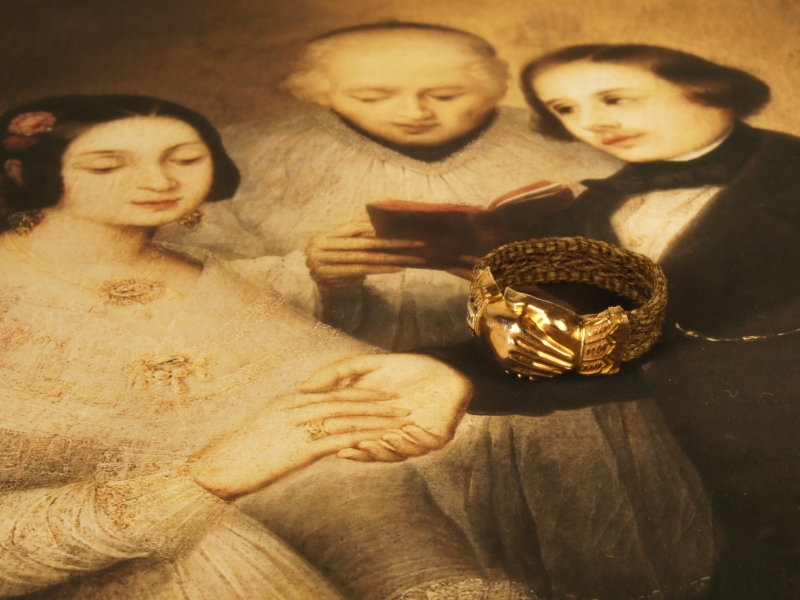
Fig. 12: Collection TN: Biedermeier, around 1840, gold, enamel, hair. Wedding ring. The clasped right hands adorn the ring bezel made of mechanically pressed gold. The hands, which were pressed and sawn out by hand or cut out by machines, had a base underneath, i.e. they were provided with a metal base, and the cuffs were enamelled in black and white. The brunette hair forms the ring band and is woven into a strong, sleek braid. This meticulous braid of hair appears to have been professionally crafted by a hairdresser rather than an amateur in the home circle.
The complicated twist-screw mechanism of the gimmel rings had been simplified from around the middle of the 18th century. Instead of the ingenious screw connection, a pin was now usually used, which allows the individual hoops to open and close like a fan (Fig. 13).

Fig. 13: TN Collection: Three gimmel rings, whose ring hoops are connected with a pin, gold, enamel. The left tripple-hoop ring, around 1780, consists of two hands with simple ruffs, which hold a double heart on the third hoop. The hands of the central tripple-hoop ring from England around 1800 are flanked on the left and right by flowers that may represent forget-me-nots. The sleeves of the right-hand German gimmel ring, engraved "June 1843", are also decorated with flowers that show remains of black and white enamel and probably also depict forget-me-nots.
×
